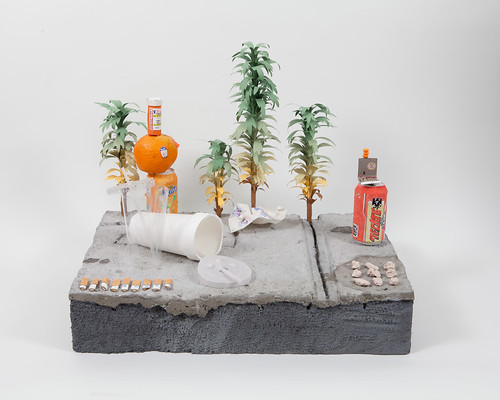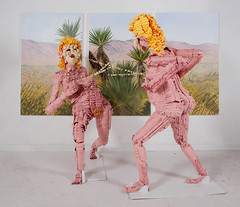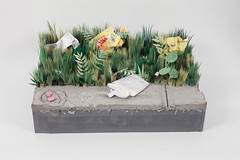“That’s a beautiful meat Popsicle,” says Dave Graw of the cooking show “Solid Dudes Kitchen.” As he speaks off-screen, two men from Detroit’s Porktown Sausage squeeze fresh sausage out of a Play-Doh Fun Factory-esque machine. “That was my nickname in high school,” says Derek Swanson, the other “Dude.”
On a recent Sunday night, the unique Detroit-ness of the cooking show delighted nearly 80 people who watched it at the pleasantly divey bar and performance space, Brooklyn Fire Proof, in Bushwick. The event was brought to Brooklyn by Paulina Petkoski and Samantha Banks Schefman, the co-founders of Playground Detroit, a New York-based non-profit that connects Detroit artists to “exposure and collaboration opportunities in New York City.”
New York is no stranger to the Motor City: last April, Detroit artist Robert Sestok installed a sculpture at First Street Green that paid tribute to his time in New York.
That’s exactly the kind of cross-pollination Ms. Petkoski and Ms. Banks, a pair of 26-year-old suburban Detroit ex-pats who now live in Williamsburg and Bushwick, want to encourage.
The two see a similarity between NYC and the D. “Look back at that film ‘Blank City’ and the Lower East Side in the ‘60s,” said Ms. Schefman, “and what a mess it seemed to be and hopeless and extremely dangerous. Part of what rebuilt [the Lower East Side] was the artist communities that decided to stay and find inspiration in the dilapidation and in what other people fear.”
Earlier this month, Playground Detroit announced that New York City artist Michelle Matson would be the first to participate in the non-profit’s Spring 2013 Detroit Residency Program.
The one-month residency, a collaboration with Spread Art, will conclude with a solo exhibit at Detroit Contemporary or Whitdel Arts, depending on the medium. Ms. Matson, a 31-year-old who as a young child lived with her family outside of Detroit for three years, will also participate in a group show during Bushwick Open Studios in Brooklyn, in early June. The program covers Ms. Matson’s one-month stay, limited transportation, a few welcome and bon voyage meals, and access to community resources. Artists have to cover the cost of the trip, among other expenses. Depending on how the first one goes, Playground Detroit hopes to do one or two residencies per year.
Playground Detroit started as an idea for a one-off event, said Ms. Petkoski, a Fashion Institute of Technology grad whose day job is as a fashion designer for Rachel Roy. “Our goal was to recreate an authentic Detroit party to counteract a lot of the New York Times articles and other media hype” – meaning, she explained, the steady stream of “ruin porn” and “urban decay” stories offered up by outlets from the The Times to Time magazine.
That first event, a weekend of Detroit bands and artists in a big Williamsburg warehouse space, ultimately fell through. But it was an essential learning experience for the budding organizers. They realized they needed to create a proper entity to interest big-money sponsors and to build a “sophisticated” art event attractive to “a Chelsea audience,” said Ms. Schefman, who works at Betsey Johnson as a jewelry and watch designer by day and checks coats at the mixology bar Employees Only by night.
The desire to attract big players stemmed from Ms. Schefman’s familiarity with the art world. Her parents have deep connections in Detroit: her father is the Chair of the Foundation Department at the College for Creative Studies in Detroit’s midtown, and her mother is the Director of Contemporary Art at the high-end gallery David Klein in metro Detroit.
Fortunately, in the process of that ill-fated first attempt, Ms. Petkoski’s and Ms. Schefman’s venture became “fiscally sponsored” through Fractured Atlas, an organization that, among other things, helps creative endeavors gain non-profit status so they can accept tax-deductible donations.
Playground Detroit hosted its first proper event on May 10, 2012: nearly 100 people attended a screening of Detroit documentaries “Lemonade Detroit” and “After the Factory” that included a Q&A with the directors. “We thought it was really successful,” Ms. Petkoski said. “People came that weren’t from Detroit, who were from New York and outside of New York.”
But will Ms. Matson, or other potential artists-in-residence, experience culture shock upon arriving in Detroit? Ms. Schefman doesn’t think so. “I think [Detroit’s] becoming a lot closer to Bushwick than you realize,” she said. “There are a lot of really cute coffee shops and restaurants opening up. They’re doing a great job of adding a lot of larger, more well-known commercial installments like Whole Foods and Moosejaw. There are beautiful apartments and condos.”
In fact, the residency will be housed in a historic, 2,500-square-foot mansion in Detroit’s Mexicantown neighborhood, and the hosts, Spread Art, will supply Ms. Matson with a bicycle, access to a car (naturally, for the Motor City), and contact with the artist community. Because in Detroit, Ms. Petkoski explains, “You’re not going to show up and say, ‘This looks great.’ You really need somebody who knows what’s happening to guide you and show you what’s really happening.”
Ultimately, the biggest challenge for Playground Detroit may be convincing New Yorkers – and Americans — that Detroit matters. “America needs to wake up,” said Ms. Petkoski. “What Detroit’s been through is a very good representation of what is happening to the entire country. You can point and laugh at Detroit, but you’re essentially laughing at yourselves… If it doesn’t come back…” she pauses caught up in some emotion, “I know it’s going to, I know it. I believe it.”
Correction: Feb. 27, 2013: The original version of this post was revised to reflect an error. The project is a collaboration with Spread Art, not the Contemporary Art Institute of Detroit.






